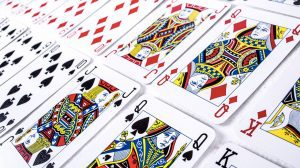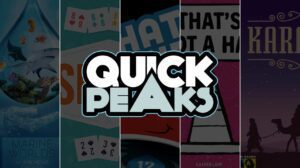In the world of hobby board gaming, no style of game has caught on quite so rapidly as the “roll and write”; a modern take on the venerable Yahtzee. The premise is simple: roll some dice, write something on your personal score sheet, rinse and repeat. Yet even within the roll and write genre there are different ways to play: some games allow for engine and combo building while others are based around set collection. Titles like Ganz schön clever (also known as That’s Pretty Clever), Fleet: The Dice Game, and Cartographers are all great examples of the roll and write genre.
But Ripple Rush, the game we’re talking about today, is a variant on the roll and write commonly called “flip and fill”. It’s the same exact play style, except that instead of rolling dice, you’re simply flipping over a card from the deck. There’s less random input since the deck is fixed… the only unknown aspect is the order in which the cards are revealed. Great examples of flip and fills are Silver & Gold, and the smash hit Welcome To…
So what does Ripple Rush bring to the party? Let’s dive in and find out.

A Rush and a Push and the Land is Ours
In Ripple Rush, players flip over cards from the deck and write a number into the corresponding color-coded column on their scoresheet. At the end of the game players will receive points for the longest chain of ascending numbers (they don’t need to be consecutive) in each of 4 columns (a max total of 8 points in each column). Players may also be eligible to score for 2 bonus cards drawn at the beginning of the game. These bonus cards award 3 points each for completing a specified horizontal row. The player with the most points wins the game!

How to Play Ripple Rush
Each player begins the game with their own deck of 20 cards, shuffled and dealt out from the larger main deck of 100 cards. Each card has two pieces of information: a color (yellow, green, blue, or red) and a number (from 1-25). As an aid to color-blind players each color is also associated with a shape.
Simultaneously players each flip over the top card of their deck and write that number somewhere in the matching color’s column. Each column has spaces for 8 numbers — the top of the scoresheet is “high” while the bottom is “low”. The only rules for placement are that each number must be written in the matching color and each number must be higher than the number immediately below it.

If you flipped over a red 1, you’d certainly want to write that at the very bottom of the red column, while if you flipped over a blue 23, you’d probably want to write it in either the topmost spot or the one just underneath it. All cards are public information, as are the scoresheets of every other player. So before selecting the resting place for your number it might be a good idea to glance at what other players have already written.
If you encounter a number that can’t be placed then you must place it into the middle of the table and announce it to the other players. For each card placed into the middle of the table, every other player may write that number on their own scoring sheet.
If a player completes a horizontal row they can use the bonus shown at the leftmost side of the scoring sheet. Rows with numbers (5, 10, 15, or 20) allow the player to write that number into any column, while rows with colored shapes allow the player to write any number into the matching colored column.

The game ends after each player has turned over all 20 cards and everyone has had a chance to mark any discarded cards on their scoring sheet.
Players receive 1 point for each mark in the longest chain in their column.
Players receive 3 points for completing a bonus card.
Tally up the points and the player with the highest score wins the game.
Final Thoughts About Ripple Rush
In the world of roll and write games Ripple Rush is on the easy end of the scale; there’s very little to consider other than which space to write the number in. You’re not even given a choice of which column (unless you’re using a row bonus)… and yet Ripple Rush is still interesting and fun, most likely because of its simplicity. I was able to teach it to all 4 of my children (ages 7-14) in just a few moments and we played an entire game in around 10 minutes.
The game is very colorful with fun abstract illustrations on the card backs, the decisions that you are given aren’t taxing or difficult to understand, and you don’t even need to count. As long as you’re able to match colors/shapes and know if one number is higher or lower than another number, you’re fully capable of playing the game.
However, people who are willing to exert just a smidge more effort might find the game more rewarding. As I mentioned earlier you could play the entire game only looking at the cards you turn over or the ones discarded to the center. But then you’d be missing out on the opportunity to improve your score. For example you might be tempted to take a chance and write that red 4 in the bottommost space on your scoring sheet. But if you flip over a red 1, 2, or 3 then you’re giving away points to your opponents. If you know that the red 1 and red 3 have already been played, you can use that info to decide whether to push your luck.
Ripple Rush also offers a solo mode, but if that sort of thing is of interest to you I wouldn’t recommend playing it as designed. In a 5 player game (the max player count), even though you begin with 20 cards, you’re almost certain to gain access to at least 3-4 more over the course of the game. Unfortunately the solo rules don’t account for this and still only allow a player 20 cards. I’d love to see an official solo variant improve on the original rules by including say 22 cards instead of 20. Playing with 5 players was glorious and I netted a whopping 37 points (just one shy of the max of 38). In fact it might also be worth a slight variant for 5 player games for the exact opposite reason…you’re far more likely to score highly because there are 4 other players who might have to discard.

My only gripe is that the game uses euro-sized (small) cards. That’s not a problem for gameplay, in fact it helps take up less table space, but it does make shuffling the deck of 100 cards quite difficult and means you’ll probably have to “smoosh” shuffle them or shuffle them in smaller batches. It’s certainly not a deal-breaker and it helps lower the cost.
So if you’re just looking for a fun casual game that you can play with friends and family, then you can’t go wrong with Ripple Rush.











Add Comment